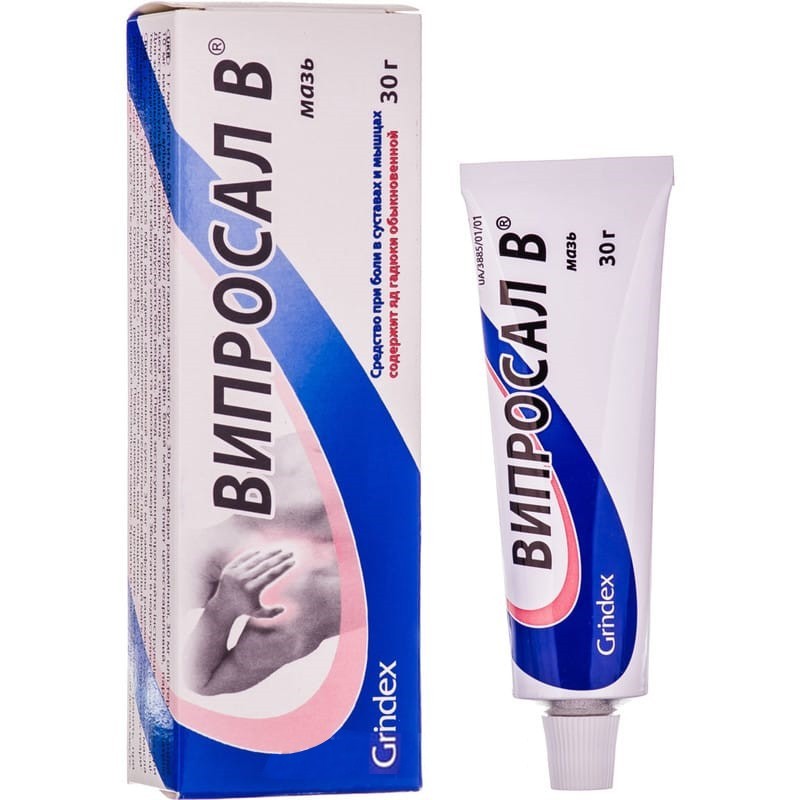



 Secure and encrypted payment processing
Secure and encrypted payment processing We ship to over 40 countries including the USA, UK, Europe, Australia and Japan
We ship to over 40 countries including the USA, UK, Europe, Australia and Japan Guaranteed refund or reship if you haven't received your order
Guaranteed refund or reship if you haven't received your orderThe main active ingredient of Viprosal ointment is venom of the common viper (venenum viperae berus), which contains phospholipase, PDE, hyaluronidase and other active substances. viper venom also contains peptides of a specific action that cause hemolysis, which increase the permeability of capillaries, affect blood coagulation. when applied topically, viper venom has an irritating and analgesic effect.
Other active substances of Viprosal B ointment, which irritate sensitive nerve endings, have a local irritating and analgesic effect. In addition to the analgesic effect of camphor, salicylic acid and turpentine oil also have an antiseptic effect, and salicylic acid has a keratolytic effect.
Pharmacokinetics The ointment is rapidly absorbed and after a few minutes there is a burning sensation, mild hyperemia of the skin and a feeling of warmth. The analgesic effect occurs after 20-30 minutes and lasts 1.5-2 hours.
Anesthetic for external use for pain in joints and muscles.
For external use. ointment is applied to the painful area in a small amount of 5-10 g (1-2 teaspoons) and rubbed into the skin, depending on the intensity of the pain 1-2 times a day until the pain syndrome disappears. the duration of the course of treatment depends on the nature and severity of the disease.
Elderly patients. There is no evidence that the elderly require a different dosage.
Children. There is no experience with children, therefore, use in this category of patients is not recommended.
Hypersensitivity to any component of the ointment, acetylsalicylic acid or other NSAIDs; ba; whooping cough; tendency to bronchospasm; tendency to cramps; ulcers and other skin diseases; acute pulmonary tuberculosis; cerebrovascular and coronary circulation disorders; tendency to angiospasm; severe renal or liver dysfunction; fever; general fatigue.
With increased sensitivity of the skin to the components of the ointment, itching, swelling, or hives may occur during use. allergic reactions can also occur, including contact dermatitis, rashes, redness, burning; headache, dizziness; possibly convulsions caused by camphor.
In this case, it is recommended to stop treatment and wash the ointment off the skin. These symptoms disappear after discontinuation of treatment.
To prevent the occurrence of side effects, it is recommended to first apply a small amount of ointment on the skin to determine the sensitivity to the drug.
Ointment should not be applied to damaged skin. To avoid severe irritation, you need to make sure that the ointment does not get into the eyes or on the mucous membrane.
You can not apply a bandage to the place of application of the ointment, you can only slightly cover it.
The ointment contains cetostearyl alcohol, which can cause local skin reactions (including contact dermatitis).
Use during pregnancy and lactation. It is contraindicated to use during pregnancy and lactation.
The ability to influence the reaction rate when driving vehicles or working with other mechanisms. Does not affect.
Not studied. although there have not been sufficiently controlled interaction tests, it is possible that excessive use of salicylates for topical use may increase the effect of coumarin anticoagulants and antiplatelet drugs. caution is required in patients receiving coumarin anticoagulants and antiplatelet drugs, including acetylsalicylic acid.
If it gets on the mucous membrane and is used in too much, the ointment causes severe irritation.
Incorrect use. Accidentally swallowing the ointment can cause gastrointestinal symptoms such as vomiting and diarrhea. The treatment is symptomatic.
If large amounts of the ointment are accidentally swallowed, symptoms of acute poisoning can occur, such as nausea, vomiting, abdominal pain, headache, dizziness, sensation of heat / redness, cramps, respiratory depression, and coma.
Observation and treatment of patients with severe gastrointestinal or neurological symptoms of poisoning is symptomatic. Do not induce vomiting.
At a temperature not exceeding 25 ° c. Do not store in the refrigerator and freezer.